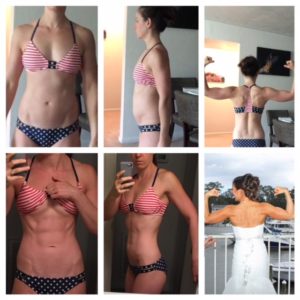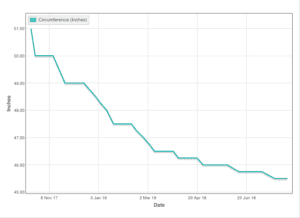Despite knowing that the scale should not be the end-all-be-all, many women aren’t really sure what else they should be tracking in order to gauge their progress.
There are dozens of other factors that maybe be as – if not more – important as your scale weight.
This article will give you plenty of ideas for gauging progress.
Why The Scale Isn’t Everything
The scale can’t tell if you’re retaining water, if you left your combat boots on, if you have a big ol’ poo brewing. All the scale knows is the mass of your body based on the force exerted on it.
By no means am I saying it’s useless but it’s certainly given a lot more weight (for lack of a better word) than it warrants.
I’ve written all about factors that can impact the scale so click over to that article if you need a reminder.
You are not required to use the scale at all. In fact, if it does more harm than good, you may just be better off taking a hiatus and focusing on other progress indicators.
If you do decide to continue using the scale (because you’re able to do so and remain sane), remember that a single weigh-in only tells you about that instant in time. What’s important is how the data trends. Don’t dwell on one, single data point, but track your results over weeks and months and look for what’s happening overall.
If Not The Scale, Then What?
Additional factors that you decide to track may vary depending on what’s important to you but there are 2 that I recommend just about everyone use regularly.
Photos
“A picture is worth a thousand words” rings true with regards to bodily changes. Typically, changes in body composition happen so gradually that we may not notice our improvements until months down the road.
Taking photos monthly or every couple of weeks allows you to compare them side-by-side and is a great way to become aware of the subtle changes that may go unnoticed, otherwise. 
It might be a little painful to document how you’re looking at the moment but I’ve never had a single client regret taking “starting” photos. If necessary, take them wearing whatever level of clothing coverage you’re comfortable with and then don’t look at them again for a month. If you’re consistent with your diet and exercise during that time, the positive changes will be undeniable.
Make sure you set up your camera somewhere that will capture your whole body and take a picture from the front, side, and back – sometimes the most apparent changes are the ones you won’t be able to see in a mirror!
You don’t even need a second person to take you pictures, the Progress Indicator Cheat Sheet bundle will show you how to take full-body pics – solo!
Circumference Measurements
In addition to photos, I recommend taking circumference measurements in at least a few places – these can vary based on the body parts that are most important to you.
Hip and waist measurements are two that I suggest for just about everyone – often times measurements here will change drastically – even with little-to-no change on the scale. 
Other body parts to consider are your neck, shoulders, chest, upper arm, thigh, and calf.
The most important thing is that you consistently measure the same spot to avoid making yourself crazy with fluctuations due to inaccurate measurements.
This Progress Indicator Cheat Sheet bundle will show you exactly where to measure the aforementioned spots so that you’ll get accurate data each time.
To these two important progress indicators, I would add a third: how clothing is fitting. Regardless of what the scale says, clothes don’t lie. If your frequently worn items start fitting differently, that’s an indication that your physique is changing. You may notice the waist in your pants getting loose, having to go down a belt loop, or needing a new work uniform. The scale may say no change (or even a slight increase – gasp) but changes in how your clothing fits are too important to overlook.
Progress In The Gym
It’s important to track your workouts in some way, whether it’s a paper journal, an app, or other format. Recording your weights, times, and speeds makes it effortless to look back and see how far you’ve come.
If you are new to exercise, especially, initial results will come quickly and looking back at your progress will help motivate you to keep showing up and putting in the work.
There are all sorts of exercise-related indicators that you can use for motivation and gauging your progress:
- Increasing weight on an exercise
- Doing more reps at the same weight
- Doing more sets at the same weight
- Getting a larger range-of-motion on an exercise
- Jogging longer without a break
- Running a mile faster than before
- Doing sprints at a faster speed
- Rowing a certain distance faster than before
- Walking at a steeper incline without holding on
- Doing more flights of stairs before needing to stop, or in a faster time (without holding on)
- Becoming more flexible in a certain body part (hamstrings come to mind)
- Trying a new exercise that you were scared of before
- Progressing to a more challenging variation of an exercise (for example, adding weight to your squats or doing push-ups on the ground instead of a bench)
- Taking a class that previously intimidated you because you felt you weren’t in good enough shape
Setting incremental goals in a few of the above areas is a great way to motivate yourself to keep showing up and putting in the work.
Progress In Your Nutrition
Consistent exercise is important for a multitude of reasons but losing significant weight also means making changes in what you eat.
Don’t overlook the importance of nutritional progress in areas such as:
- Eating more/varied veggies
- Eating more/varied fruit
- Eating more/varied lean protein
- Replacing not-so-healthy fats with healthy fats
- Replacing processed carbs with smarter ones
- Drinking more 0-calorie beverages (and fewer caloric ones)
- Slowing down and learning to listen to your body’s hunger and fullness cues when you eat
- Cooking more meals at home
- Making smarter choices at restaurants
- Cutting back on alcohol
- Using a grocery list to cut down on waste and junk food
- Shopping farmer’s markets or directly from local farms
- Doing less mindless snacking
- Addressing emotional eating patterns with healthier behaviors
- Doing consistent kitchen clean-outs
- Determining your nutrition BAMs
- Combatting the all-or-nothing or “f*%! it” mentality
- Reducing unworthy indulgences
- Learning to say “no” to food pushers
- Not feeling like you need a nap after meals
- Learning how to stop before you’re stuffed
- Noticing a decrease in cravings
Lifestyle Related Progress
Progress isn’t just about aesthetics, gym accolades, or cleaning up your diet. How your lifestyle improves overall is arguably the most important area to progress.
Lifestyle related progress might include:
- Having more energy when you wake up
- Eliminating or reducing the 3pm slump at work
- Having more energy after work
- Napping less frequently or long
- Getting more restful sleep
- Getting more sleep overall
- Developing a nighttime ritual
- Spending less time on electronics
- Spending less time being sedentary
- Developing a new, healthy hobby
- Feeling better about yourself
- Noticing an increase in motivation
- Increased self-confidence
- Seeing your kids influenced by your healthy example
- Noticing a decrease in existing conditions (acne, inflammation, bloating, depression, anxiety, etc.)
- Taking a lower dose of medication or coming off completely (as recommended by your doctor, of course)
What To Track Is Up To You
I suggest taking photos and circumference measurements on a regular basis in addition to using the scale (if you are able to without obsessing) and then picking a couple of progress indicators from the Exercise, Nutrition, and Lifestyle categories that are important to you.
Recognizing your progress in a multitude of areas not only gives you a better idea of the big picture but it helps keep the results on the scale in perspective.
The Progress Indicator Cheat Sheet bundle will help you take progress pics without a photographer, take consistent and repeatable measurements, and determine what other factors are important to you.




